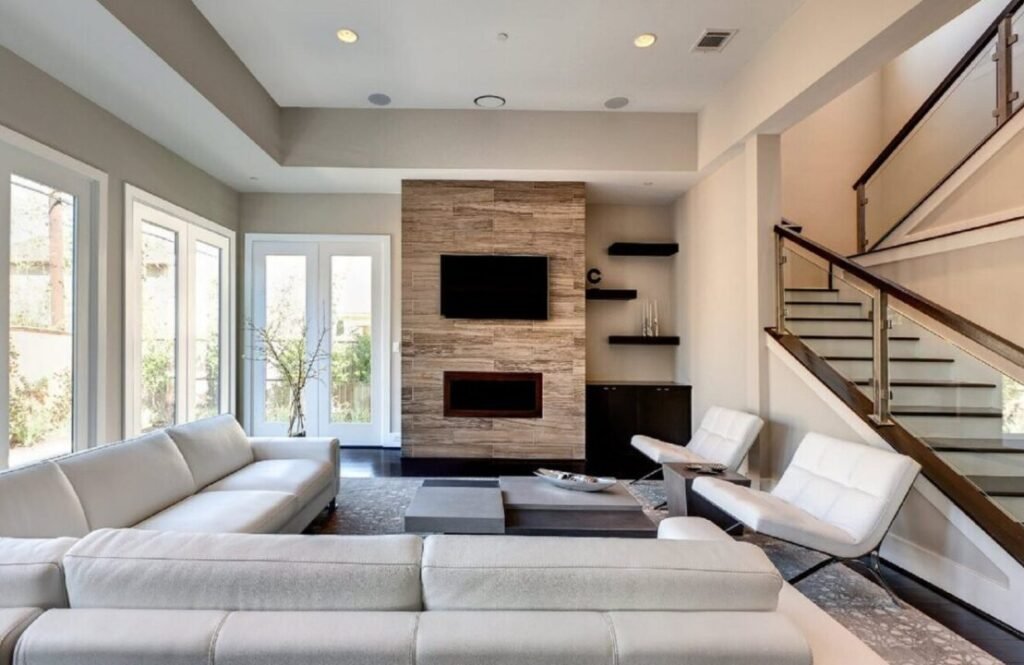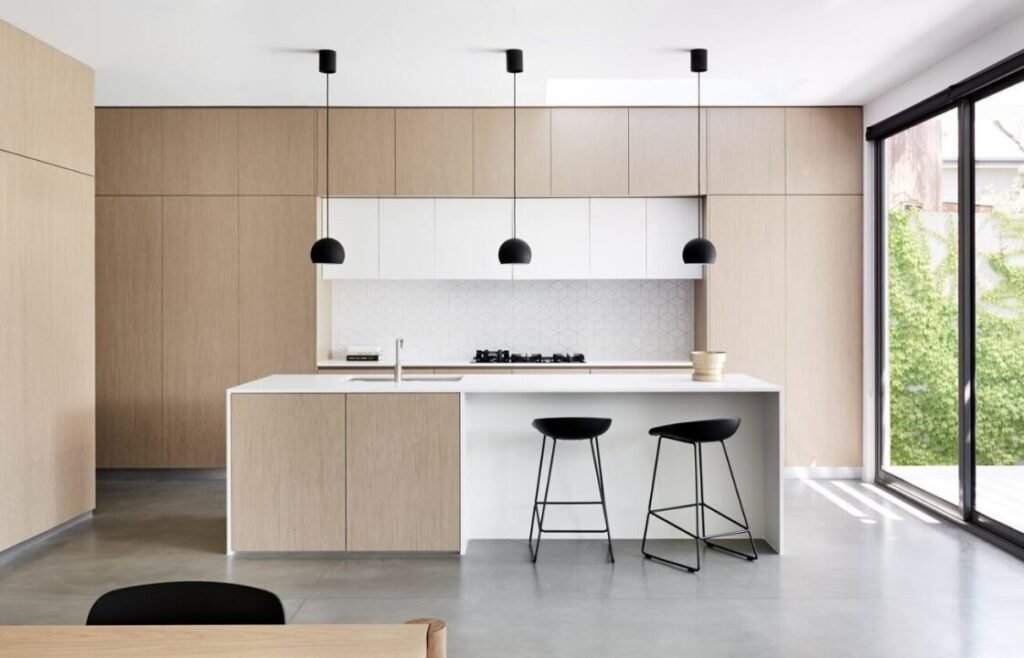Immerse yourself in the world of design and mood.
Colors affect your feelings; warm tones cozy you up, while cool tones relax. Lighting plays an essential role, with natural light lifting spirits and artificial hues creating ambiance.
Spatial layout influences emotions; open layouts bring freedom, segmented spaces coziness. Furniture arrangement impacts well-being; ergonomic designs support posture, adding practical value.
Textures create comfort and engagement; touch elevates sensory experiences. Achieving symmetry and balance in design brings aesthetic harmony. Adaptive designs uplift emotions, connecting you to nature.
The psychology of space design is a journey into your emotions and well-being.
The Impact of Color Psychology
When choosing colors for your living space, consider how different hues can directly influence your mood and overall well-being.
Color combinations have a profound emotional impact on how you feel in a room. For example, warm tones like reds and yellows can create a cozy and inviting atmosphere, perfect for social gatherings.
On the other hand, cool tones such as blues and greens can promote relaxation and calmness, ideal for a peaceful retreat after a long day.

Cultural influences also play a significant role in color choices.
Different cultures associate varying meanings with colors.
For instance, in some Eastern cultures, red symbolizes luck and happiness, while in Western cultures, it often represents passion or danger. Being aware of these cultural nuances can help you create a living space that resonates with your personal preferences and values.
Lighting Effects on Mood
Consider how the lighting in your living space can greatly impact your mood and well-being, much like the colors you choose.
Natural light, with its dynamic qualities, can uplift your spirits and enhance your overall sense of well-being. It helps regulate your circadian rhythm, contributing to better sleep patterns and increased productivity during the day.
On the other hand, artificial lighting plays an important role in setting the ambiance of a room.
Warm-toned lights can create a cozy and inviting atmosphere, perfect for relaxation, while cool-toned lights promote alertness and focus, ideal for workspaces.
Mixing both natural and artificial lighting sources can provide a balanced environment that caters to different needs throughout the day.
By incorporating adjustable lighting options, you have the flexibility to adapt the ambiance to suit various activities and moods.
Whether you’re looking to create a calming sanctuary or a vibrant workspace, the right combination of natural light and artificial lighting can greatly enhance your emotional well-being within your living space.
Spatial Layout and Emotions
Improving your living space’s spatial layout can greatly impact your emotional experiences and well-being.
The way your home is spatially organized can have a significant effect on your cognitive response and emotional state.
Spatial design plays an essential role in shaping the atmosphere of a room, influencing how you feel when you enter it.

When considering spatial organization, think about how different areas flow into one another.
An open layout can create a sense of freedom and connection, whereas segmented spaces might evoke feelings of coziness and intimacy.
The way furniture is placed within these spaces can further enhance the emotional impact. For example, a central gathering area can promote social interaction and a sense of togetherness.
Furniture Arrangement for Well-being
To foster a harmonious atmosphere in your living space, purposeful furniture arrangement can greatly contribute to your overall well-being and emotional balance.
Consider incorporating ergonomic seating options that support your body while promoting comfort and good posture. Opt for chairs and sofas that provide proper lumbar support and adjustable features to customize your seating experience.
By prioritizing ergonomic seating, you can reduce physical discomfort and enhance your relaxation and focus within your home.
Furthermore, focus on functional decor that not only serves an aesthetic purpose but also adds practical value to your space.
Choose furniture pieces that offer storage solutions or multi-functional use, helping you maintain a clutter-free environment and maximize the functionality of your living areas.
By integrating furniture items that are both visually pleasing and serve a purpose, you can create a space that feels organized, efficient, and conducive to your well-being.
Keep in mind, the way you arrange your furniture can greatly impact how you feel in your home, so aim to design a layout that promotes harmony and comfort.
Textures and Comfort in Design
Enhancing the ambiance of your living space, textures play a significant role in creating a sense of comfort and visual interest in interior design.
The tactile sensations provided by different textures can elevate your sensory experiences and contribute to a cozy ambiance. Incorporating plush rugs, soft throws, or velvet cushions can invite you to unwind and relax after a long day.
Imagine sinking into a deep armchair with a knitted blanket draped over it – the combination of materials offering warmth and softness to the touch. Textures like smooth wood, rough stone, or fluffy fabrics each bring a unique element to your space, engaging not just your sight but also your sense of touch.
Running your hands over these varied surfaces can act as relaxation techniques, soothing your mind and body.
Nature Elements in Spaces
Embrace the calming presence of nature by incorporating organic elements into your living space, enhancing the harmony between your indoor environment and the outdoors.
This design approach, known as biophilic design, focuses on integrating natural elements in interiors to create a more soothing and balanced atmosphere.
By bringing elements like plants, natural light, water features, and natural materials such as wood and stone into your space, you can evoke a sense of tranquility and connection with the outside world.
Biophilic architecture goes beyond just adding greenery; it involves a thoughtful indoor nature integration that mimics outdoor environments to promote well-being. Imagine a living room with large windows that offer views of lush greenery, or a bedroom with a small indoor garden that purifies the air while adding a touch of serenity to your personal space.
Personalization and Emotional Connection
Infusing your living space with personal touches creates a deep emotional connection that resonates with your unique identity and influences your mood.
By incorporating elements that reflect your personality, interests, and experiences, you not only showcase your individuality but also create a sense of comfort and belonging within your home.
These personal touches serve as a form of emotional expression, allowing you to communicate aspects of yourself to others and reinforcing your connection to the space.
Whether it’s displaying cherished photographs, collecting souvenirs from travels, or showcasing artwork that speaks to your soul, these items can evoke positive emotions and memories, fostering a sense of happiness and contentment.
Personalization goes beyond mere decoration; it transforms a house into a home, a place where you feel truly understood and accepted. Your living environment becomes a canvas for personal connection, where every object tells a story and contributes to the overall atmosphere of warmth and familiarity.
Embrace the power of emotional expression through personalizing your space and watch as it transforms into a sanctuary that uplifts your spirits and nurtures your well-being.
Minimalism Vs. Cluttered Spaces
When considering the design of your living space, the contrast between minimalism and cluttered spaces can greatly impact your mood and overall well-being.
Minimalism embodies organization and simplicity, promoting a sense of calm and clarity. A minimalist space with clean lines and uncluttered surfaces can help reduce stress and create a feeling of openness.
On the other hand, cluttered spaces represent chaos and complexity. An environment filled with excess items can lead to feelings of overwhelm and distraction, hindering your ability to relax and focus.

Choosing between minimalism and cluttered spaces is a personal decision that reflects your inner state. If you crave order and tranquility, opting for a minimalist design can provide a sense of harmony and balance.
In contrast, if you thrive in a dynamic and visually stimulating environment, a cluttered space filled with vibrant objects may spark creativity and inspiration.
Ultimately, finding the right balance between organization and chaos, simplicity and complexity, is key to creating a living space that resonates with your unique personality and fosters a positive mood.
Symmetry and Balance in Design
Achieving symmetry and balance in your design can greatly influence the overall aesthetic appeal and harmony of your living space.
When elements within a room are visually balanced, it creates a sense of order and stability that can evoke feelings of peace and tranquility. Visual harmony is key in design; it allows your eyes to move effortlessly around a space without feeling overwhelmed or unsettled.
Design equilibrium isn’t just about having identical objects on each side of a room, but rather about distributing visual weight evenly.
This can be achieved through the careful arrangement of furniture, artwork, and decor items. For instance, placing a large, visually heavy piece on one side may be counterbalanced by several smaller, lighter pieces on the other side.
Adaptive Design for Mood Enhancement
Enhance your mood through adaptive design, tailored to uplift your emotions and well-being in your living space.
By applying principles of environmental psychology, you can create a harmonious atmosphere that promotes positivity and tranquility.
Utilizing biophilic design, which incorporates elements of nature, can greatly impact your mood by fostering a connection to the outdoors within your home.

Sensory stimulation plays an important role in adaptive design for mood enhancement.
Consider integrating textures, colors, and lighting that engage your senses and evoke feelings of comfort and joy. Through sensory integration, you can create a multi-sensory experience that enhances your mood and overall sense of well-being.
The End
As you navigate through different spaces, keep in mind that design has a powerful impact on your mood and emotions. From the colors on the walls to the layout of furniture, every detail plays a role in shaping how you feel.
By understanding the psychology of space, you can create environments that promote well-being and enhance your overall experience.
So next time you step into a room, take a moment to ponder how its design influences your mood.

